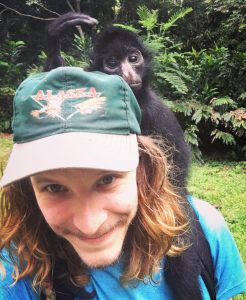
Shane with a local friend. Photo by Rommel
My name is Shane Palkovitz. I am a socioenvironmental specialist for the Songs of Adaptation research project at Future Generations University. The core investigations of this project focus on establishing an international baseline for biodiversity, while at the same time gathering knowledge from community members about human adaptation to climate change.
In March, I had the joy of traveling to Bolivia to work with local partners to establish a new research location. Our goal was to install four monitoring stations that will later serve as the beginning point for a larger research project.
We spent the first few days trekking through the jungle, looking for sites and gathering information before installing instrumentation. Pictured below, Alejo follows as other team members venture up a stream bed on El Chocolatal, an eco-resort.

Working together with local partners, we designed a preliminary study near Rurrenabaque. This installation includes four monitoring stations in different habitats, all within a 500-foot elevation range. The study design relies on community partners to collect and transfer data.This study design relies on local community partners to collect and transfer data.
The monitoring stations each include a bioacoustic recorder and a climatic logger. The audio recorders make five-minute long sound files, then go to sleep for ten minutes. Then they wake up and do it again, all day, round the clock, week-in and week-out throughout the year. The climatic logger notes the temperature and humidity every fifteen minutes, when the bioacoustic recorder powers on. Over time, we hope to see meaningful trends emerge in the data.
At the first monitoring station, I showed the local team how to complete the install. At subsequent stations, I stood back to allow team members to demonstrate that they had learned how to work with the equipment. Below, Luciano, Alejo, myself, and Rommel are scheming and dreaming after installing the instrumentation at the Copaibo monitoring station.

Photo by Professor Dan Robison
It is important that local team members be able to carry on the program without outside help being present on site. While the first wave of instrumentation is in place and generating data, team members are already in the early stages of designing a biomeridian (a transect of monitoring stations, over an elevation gradient) that will reach from the first four monitoring stations across a large expanse and finally terminate above the tree line.
While the current stations are hoped to be the beginning of a longer transect, they are also fully functional on their own. Initial bioacoustic data is rolling in now. Through time, we will have an auditory record of bird species location. However, plats don’t sing. If temperature shifts are causing plant species to make elevational shifts as well, we want a record of that.
We live at a strangely suspended moment in the world, where indigenous people in many locations walk barefoot through jungles, smartphones in-hand. We started an iNaturalist collection project to help document biodiversity from afar. We spent a few days around the monitoring stations, using smartphones to photograph plant and animal life. In Bolivia, local team members have extensive knowledge about native flora and fauna. We were able to work together to learn how to use the iNaturalist (“Naturalista” is the Spanish version) application to document species that cannot be recorded in song. One very interesting phenomenon that we observed together was a group of Morpho Telemachus caterpillars, all clinging to a single leaf (pictured below).

After spending a few days installing the first three stations and documenting biodiversity, we installed the fourth station in a climax forest at Jaguarate. A climax forest is one that has been undisturbed for long enough to reach its successional peak. This forest has been protected from blades for hundreds of years, and the trees have flourished into stunning maturity. Pictured below, Romel, Cachi, Dan and Eric set out into the mosquito-ridden floodplain region.

This largely untouched forest is a couple miles out onto the flatlands that drain into the Amazon. In this region, there are many oxbow lakes and other evidence of rivers shifting over time. In initial exploration, some of the same birds that occupy the foothills at el Chocolatal (the location of the other three observation stations) were heard and identified by ear in this forest. While the range of some species may overlap, there will also be differences due to the age of the forest. Cachi, one of the owners and protectors of the land, says that some of the trees may be as old as 600 years. Their grandeur is difficult to capture with the camera lense; you can see the trekkers looking like tiny toy humans next to the massive trunk of a Cachichita tree.

After returning from installing the fourth station, the team visited to first three observation stations to collect data from the first week of recording. Pictured below, Luciano and Alejo listen to songbird vocalizations from the bioacoustic recorders.

Together, we listened to the audio recordings to explore the data. We will rely on computer programs to process large batches of data. Some of our team members are currently designing a more sophisticated automated system of species identification. As it is now, we use human knowledge to train data sets. Our current programs can scan a month’s worth of data (approximately 75 GB: 28mb per 5-minute WAV file, 4 per hour, recording around the clock) and group the vocalizations into clusters; we have to manually teach the computer which clusters are the sounds of which species.
It was an absolute joy to explore different ecozones of the Bolivian jungle with local community members. The preliminary research sites are up and running; data is being collected now, as you read this. We are excitedly analyzing it and comparing it with the relative silence of audio files from our bioacoustic recorders that were riding through the bleak North American winter at the same time.
Thank you so much for taking the time to explore with me; I look forward to keeping you updated on happenings with the Songs of Adaptation project from Bolivia, and other locations around the world.
Cheers,
Shane
______________________________________________________________________________
If you have enjoyed this update, and you would like to be connected to a global community using bioacoustics and local knowledge for climate change monitoring, you can join us on the adventure! There are a number of ways you can participate:
– Follow along on Instagram, Twitter, or Facebook.
– Make a donation or sign up to host a research site on the project website.
– Join our iNaturalist collection project as a citizen scientist, and get to see hundreds of observations from around the world!


